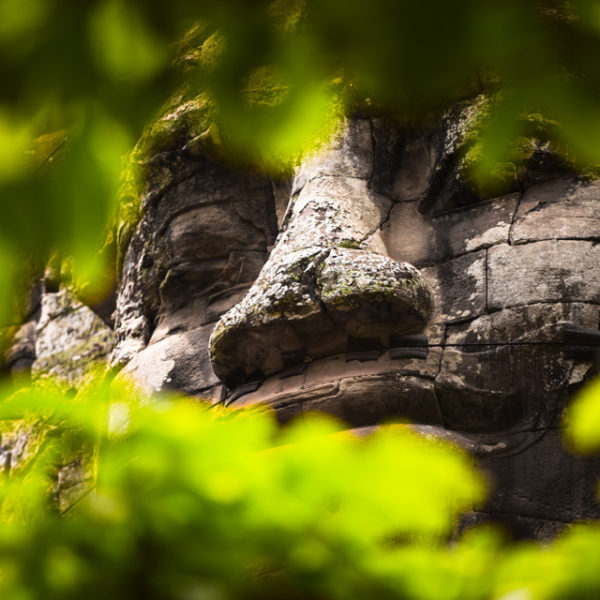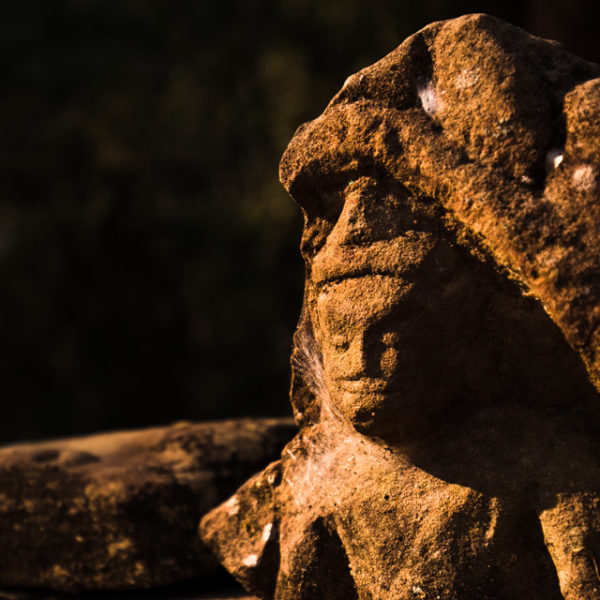

Angkor Thom photography tips
Opening Hours 7.30-5.30 (although the roads in and out of here are open before sunrise and after sunset)
Tripod restrictions – No (not at time of writing)
The impressive city of Angkor Thom holds a delight for the photographer, it’s center being the iconic multi faced Bayon. A host of other temples lie within the city walls at various states of repair, all well worth exploring. Add to this, there are a handful of active pagodas occupied by Buddhist monks. For a photographer, the whole area has a good chance of producing some magical images.
Walls of Angkor Thom
The city of Angkor Thom has a wall running around it’s perimeter, each side is three kilometers with gates on each cardinal direction. The wall, built from laterite, offers a great escape from the crowds. Walk, or cycle this path any time of day, you will see almost no tourists.
The first gate most people visit will be south gate, a busy spot being the main entrance to Angkor Thom. It lies in a relatively open area, making it a common sunset spot for photographers and tourists alike. Sunrise may also be a possibility here. Either side of the causeway are twenty six god’s and demons supporting giant multi headed naga (snakes), protectors of the city. The gods and demons are the most intact here at the expense of the other gates. Some of the restored heads are cast concrete, a short term solution, however they do look good. A close up on these faces with, perhaps with the gate in the background is well used in travel magazines.
North gate also sees it’s fair share of traffic. It’s surrounded by trees so attracts the mosses and lichen, especially during wet season. Cambodia, known for wet and dry seasons, being in the Northern hemisphere also has spring and autumn. Expect falling leaves in winter months, blossom during spring and lush green foliage starts from March, soon helped with the onset of rainy season. Make use of these vivid colors both on the buddha faces of the gates and surrounding foliage. North gate also has a spectacular tree root on the inner side with great leading lines to the archway.
The west gate is easily accessible and still has a dirt road adding to it’s authenticity, the only other gate not sealed is east gate. Most of the gods and demons lay in ruins here. It is a nice spot late afternoon with the soft falling sun. If you are patient, wait here and the temple workers to return home. Ladies on pushbikes dressed in their traditional krama will pass, nice touch to your images. Gondolas are for hire here for an evening’s sunset ride to south gate.
Victory gate again is fairly busy with traffic. Unlike south gate, fewer people stop here. It is worth the effort to get out of your tuk tuk and walk up the sides of the gate, getting close to the buddha face. Again, make use of the foliage and tree roots to add something to your shot. Finally, east gate, the least visited of all gates. The path to here leads from the east of Bayon. It is rough and not sealed. If solitude is your thing, this place is for you.
At each corner of the wall there is a small temple, a good possibility for sunrise or sunset far away from the crowds. All corner temples are similar in design, the best preserved lies in the South East corner. December sees the sun rise ESE and set WSW while in June the rise and set would be ENE and WNW, plan your trip accordingly. A great app for astrological positions is planit, where you can determine the position of sunrise, sunset and many other things for any time of the year. Remember, If on foot, these corner temples would be a 1.5 kilometer walk to or from your transport.
Angkor Thom Elephant Terrace & beyond
Perhaps the most common place or visitors within Angkor Thom other than Bayon temple is the Elephant terrace. To the north is the terrace of the leper king with it’s corridor of never ending carvings, well worth a visit offering some great photo opertunities. Explore west and east of here for a few off the beaten trek gems.
The towers to the east of elephant terrace offers some nice early morning soft light. Wait for the sun to get to around 25 degrees above the horizon, coupled with the moisture in the air, if you are lucky the sun rays will come through giving great lighting conditions. Shoot into the sun, wait around for that perfect moment and you may get lucky. All this area is worth exploring any time of day away from the crowds on the main terrace. Head to Wat Prampei Loveng to the Buddha statue once located in central Bayon, a common place of worship for monks, nuns & locals alike. Escape the crowds and explore north of here to the Preah Pithu structures.
There are many pagodas around here with resident monks, often seen giving blessings to the locals, great for culture photography. If this is your thing, approach respectfully and make sure your subject is comfortable with the camera. The monks are often busy in the mornings, as they can not eat after mid day. Afternoon sees the monks giving blessings, great for photos. Also of interest for the photographer maybe the daily activities of the monks around their pagodas.
West of elephant terrace is also worth a wonder. Explore from Prasat Preah Palilay, Phimeanakas and onto Baphuon (don’t miss the giant reclining Buddha – if you can make it out) with it’s great high views. Theres plenty of foliage around here which will encourage mosses and lychee on the reliefs during rainy season.
If you have time to spare it is well worth exploring this whole area including the city walls. Take your time and look beyond the main structures, you never know what delights you may find.
Want a photography tour? Book here.
Check out these 6 stunning photographs of Angkor Wat, including camera settings!
You may also like Angkor Wat survival guide for photographers.
Check our photography guides to the other temples:
Preah Khan, Banteay Kdei, Bayon, Ta Prohm, Banteay Srei











